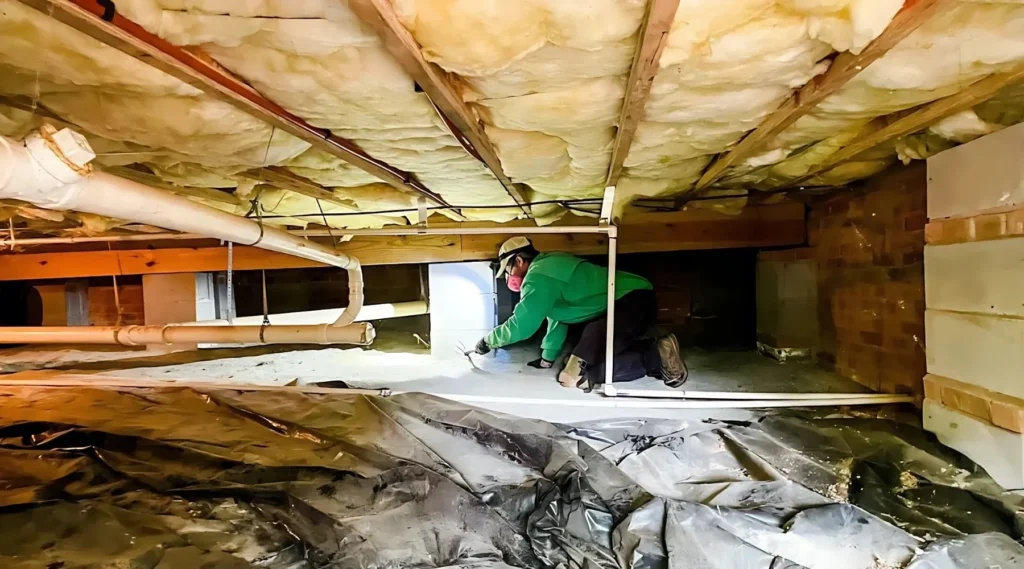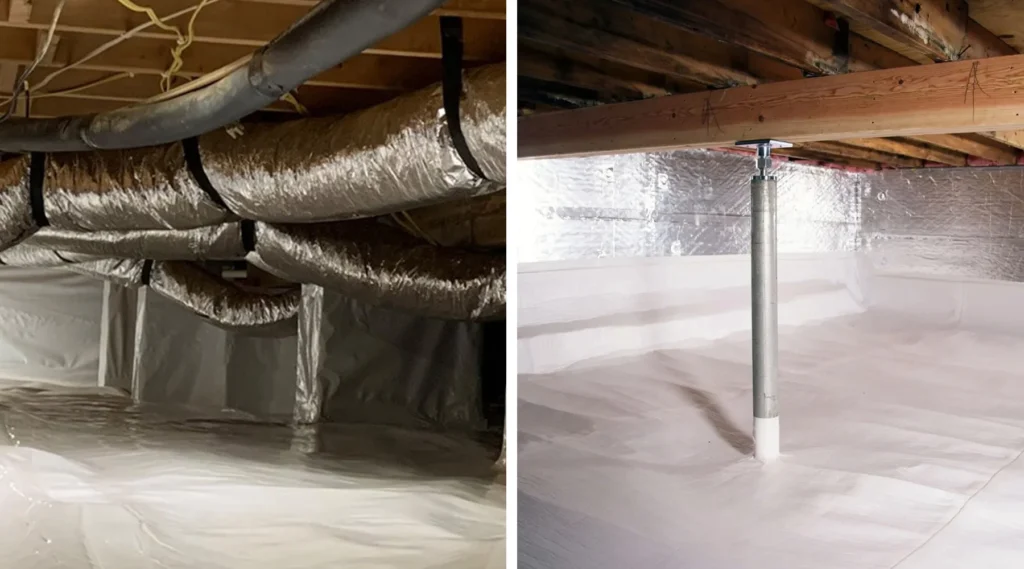If you’ve been researching solutions for moisture problems in your crawl space, you’ve likely come across terms like “encapsulation” and “sealed crawl space.” While these terms are sometimes used interchangeably, there are important distinctions between these approaches that can impact your home’s health, energy efficiency, and your wallet. At Tri-State Waterproofing in Gainesville, we’ve been helping homeowners address crawl space issues for over 20 years, and we’re here to clarify these differences.
Before you decide between sealing or encapsulating your crawl space, it’s worth understanding what it takes to moisture-proof a crawl space effectively and why it matters for long-term protection.
Understanding Crawl Space Basics
Before diving into the differences between encapsulation and sealed crawl spaces, it’s helpful to understand why crawl space protection matters. Your crawl space plays a crucial role in your home’s overall health and efficiency. When moisture infiltrates this area, it can lead to:
- Mold and mildew growth
- Wood rot and structural damage
- Increased humidity throughout your home
- Higher energy bills
- Poor indoor air quality
- Pest infestations
Traditional crawl spaces were designed with vents to promote air circulation, based on the theory that this would keep the area dry. However, modern building science has revealed that in humid climates like those in the Southeast, these vents often introduce more moisture problems than they solve.
Crawl Space Encapsulation: The Comprehensive Approach
Crawl space encapsulation is a comprehensive moisture control system that completely isolates your crawl space from the outside environment and ground moisture. This method involves several key components:
Key Elements of Crawl Space Encapsulation
- Heavy-duty vapor barrier: A thick (typically 10-20 mil) polyethylene liner is installed over the entire crawl space, including the floor, foundation walls, and sometimes the ceiling. This liner is carefully sealed at all seams and penetrations.
- Sealed foundation vents: All existing vents are sealed to prevent outside air from entering the crawl space.
- Moisture control system: Depending on your specific situation, this might include:
- A dehumidifier to maintain optimal humidity levels
- A sump pump if groundwater is an issue
- Drainage systems channel water away from the foundation.
- Insulation: Proper insulation of the foundation walls (rather than between floor joists) to create a thermal envelope.
- Air sealing: All potential air leaks are sealed, including around pipes, wires, and the sill plate.
Benefits of Full Encapsulation
A properly encapsulated crawl space offers numerous benefits:
- Superior moisture control: The complete vapor barrier system prevents ground moisture from entering the space.
- Improved energy efficiency: Studies show energy savings of 15-18% in homes with encapsulated crawl spaces.
- Enhanced indoor air quality: Since up to 50% of the air in your home comes from your crawl space, encapsulation can significantly improve your home’s air quality.
- Structural protection: By controlling moisture, you protect floor joists and other structural elements from rot and decay.
- Additional storage space: An encapsulated crawl space can often be used for clean, dry storage.
- Pest reduction: The sealed environment is less hospitable to pests and insects.
Sealed Crawl Space: The Partial Approach
A sealed crawl space typically refers to a less comprehensive approach that focuses primarily on closing foundation vents and perhaps adding a simple vapor barrier on the ground. This method addresses some moisture concerns but falls short of the complete system offered by full encapsulation.
Key Elements of a Sealed Crawl Space
- Closed foundation vents: Existing vents are sealed or closed to prevent outside air from entering.
- Basic vapor barrier: A lighter-weight plastic sheeting is laid on the ground, often without extending up the walls or being meticulously sealed at seams.
- Limited moisture control: This may include basic measures like improving exterior drainage, but it typically lacks comprehensive moisture management systems.
Limitations of Simply Sealing a Crawl Space
While sealing foundation vents and adding a basic ground cover is better than nothing, this approach has several limitations:
- Incomplete moisture barrier: Without a complete, sealed vapor barrier system, ground moisture can still evaporate into the crawl space.
- Potential for condensation: Without proper dehumidification, sealed crawl spaces can actually trap moisture, leading to condensation issues.
- Limited energy benefits: The partial approach doesn’t create the same thermal envelope as full encapsulation, resulting in fewer energy savings.
- Ongoing moisture concerns: Without addressing all moisture sources, problems may persist or return.
Making the Right Choice for Your Home
When deciding between encapsulation and simply sealing your crawl space, several factors should influence your decision:
Climate Considerations
In the humid Southeast, where Tri-State Waterproofing operates, full encapsulation is often the recommended approach. Our climate’s high humidity levels mean that simply sealing vents without addressing ground moisture and humidity control can sometimes create new problems.
Extent of Existing Issues
The severity of your current moisture problems should guide your approach:
- Minor, occasional moisture: A sealed crawl space with basic moisture controls might be sufficient.
- Significant or recurring moisture issues: Full encapsulation with comprehensive moisture management is likely necessary.
- Structural concerns or mold: These issues should be addressed before any encapsulation or sealing work begins.
Budget Considerations
While full encapsulation represents a more significant investment upfront, it often proves more cost-effective in the long run by:
- Preventing expensive structural repairs
- Reducing energy costs
- Avoiding the need for repeated partial solutions
- Protecting your home’s value
At Tri-State Waterproofing, we understand that budget constraints are real, and we work with homeowners to develop solutions that address their most pressing concerns while fitting within their financial parameters. We also offer financing options to make these important home improvements more accessible.
The Controversy in the Industry
As mentioned in our reference material, there has been some controversy in the crawl space industry regarding the best approaches to moisture control. Some of this stems from the proliferation of manufacturer-franchisee relationships pushing particular products or systems.
At Tri-State Waterproofing, we believe in providing honest, unbiased assessments based on building science and our 20+ years of experience in providing crawl space repair services in Gainesville. We recommend solutions based on your home’s specific needs rather than a one-size-fits-all approach.
The Importance of Professional Assessment
Perhaps the most important takeaway is that every home is unique, and the right solution depends on your specific situation. A professional assessment from an experienced crawl space contractor is invaluable in determining whether your home needs full encapsulation or if a sealed crawl space with targeted moisture controls would be sufficient.
During an assessment, a qualified professional should:
- Thoroughly inspect your entire crawl space.
- Identify all sources of moisture.
- Check for structural issues or damage.
- Test current humidity and moisture levels.
- Evaluate your home’s overall ventilation and air quality.
- Consider your local climate conditions.
- Provide a detailed explanation of recommended solutions.
The Tri-State Waterproofing Approach
At Tri-State Waterproofing, we take pride in our comprehensive approach to crawl space solutions. Our process includes:
- Thorough inspection: We conduct a detailed assessment of your crawl space and overall home moisture issues.
- Customized solutions: Rather than pushing a one-size-fits-all approach, we develop recommendations tailored to your specific situation.
- Quality materials: We use commercial-grade materials designed for long-term performance.
- Expert installation: Our experienced teams ensure proper installation of all system components.
- Ongoing support: We stand behind our work with strong warranties and continued service as needed.
Whether your home needs full encapsulation or a more targeted approach to sealing and moisture control, our team has the expertise to guide you toward the most effective solution.
Additional Considerations for Crawl Space Projects
Beyond the basic decision between encapsulation and sealing, there are several other factors to consider when planning a crawl space project:
Pest Control Implications
Some pest control companies may have concerns about fully encapsulated crawl spaces because they can make termite inspections more challenging. However, modern encapsulation systems can be installed with inspection ports and other features that maintain the ability to monitor for termite activity.
HVAC Considerations
If your HVAC system or ductwork is located in your crawl space, this can significantly impact your decision. Encapsulating a crawl space with HVAC components can improve system efficiency and indoor air quality by bringing these components into the conditioned space.
Addressing Existing Damage
Before encapsulating or sealing your crawl space, any existing damage should be addressed:
- Structural repairs to damaged floor joists or supports
- Mold remediation, if necessary
- Drainage improvements to address standing water
Long-term Maintenance
Any crawl space system requires some maintenance:
- Dehumidifiers need periodic cleaning and occasional service
- Sump pumps should be tested regularly
- Vapor barriers should be inspected for tears or damage
- Humidity levels should be monitored
Conclusion: Making an Informed Decision
The difference between an encapsulated and sealed crawl space ultimately comes down to the comprehensiveness of the approach. Full encapsulation provides a complete moisture management system that addresses all aspects of crawl space health, while simply sealing vents and adding a basic vapor barrier addresses only part of the equation.
For most homes, a properly designed encapsulation system offers the most reliable long-term solution for crawl space moisture issues. However, the right approach for your home depends on your specific situation, including:
- The extent of current moisture problems
- Your local climate conditions
- Your home’s construction
- Your budget and priorities
- Any existing damage or issues
At Tri-State Waterproofing, we’re committed to helping homeowners make informed decisions about crawl space solutions in Gainesville. With over 20 years of experience waterproofing basements and crawl spaces across, we have the expertise to assess your situation and recommend the most appropriate approach.
Don’t let crawl space moisture continue to damage your home and affect your indoor air quality. Contact Tri-State Waterproofing today for a professional assessment and customized recommendations for your crawl space needs.
Frequently Asked Questions
How long does crawl space encapsulation last?
A properly installed encapsulation system should last 15-20 years or more. Higher quality materials and professional installation contribute to a longer lifespan.
Will encapsulating my crawl space reduce my energy bills?
Yes, studies show that homes with properly encapsulated crawl spaces can see energy savings of 15-18% due to improved insulation and reduced humidity levels.
Can I encapsulate my crawl space myself?
While DIY kits are available, professional encapsulation is recommended for several reasons:
- Proper moisture assessment requires expertise
- Commercial-grade materials perform better in the long term
- Professional installation ensures all seams and penetrations are properly sealed
- Addressing all moisture sources requires experience
How much does crawl space encapsulation cost?
The cost varies depending on the size of your crawl space, the extent of existing issues, and the specific components needed. A basic sealed crawl space might cost less initially, but full encapsulation often provides better long-term value despite the higher upfront investment.
How do I know if my crawl space needs attention?
Signs that your crawl space needs attention include:
- Musty odors in your home
- High indoor humidity
- Sagging or soft floors
- Increased allergy symptoms
- Higher than normal energy bills
- Visible mold or moisture in the crawl space
- Pest infestations


